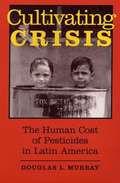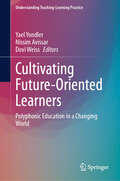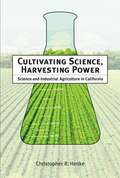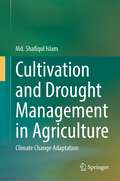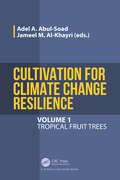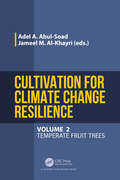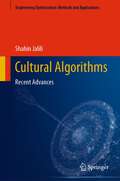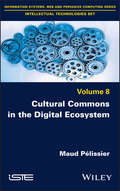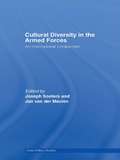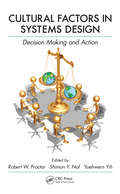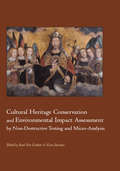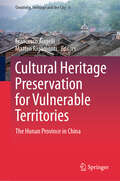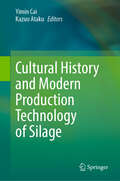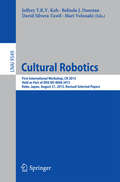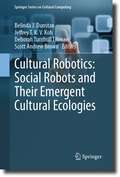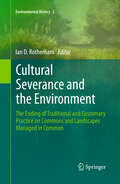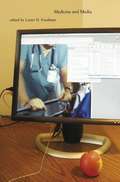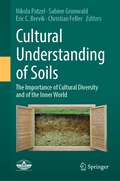- Table View
- List View
Cultivating Crisis: The Human Cost of Pesticides in Latin America
by Murray Douglas L.In this study, Douglas Murray draws on ten years of field research to tell the stories of international development strategies, pesticide problems, and agrarian change in Latin America. Interwoven with his considerations of economic and geopolitical dimensions are the human consequences for individual farmers and rural communities.
Cultivating Future-Oriented Learners: Polyphonic Education in a Changing World (Understanding Teaching-Learning Practice)
by Nissim Avissar Yael Yondler Dovi WeissThe book Cultivating Future-Oriented Learners: Polyphonic Education in a Changing World offers a new theoretical and practical educational approach, responding to our era's challenges. The polyphonic paradigm it proposes uses current educational elements to produce "a new whole" connecting technology, varied learning spaces, humanizing pedagogy, and global values of personal, social, and environmental responsibility. Combining all these elements, the presented polyphonic wisdom model enables teachers to design a technology-enhanced, pluralistic, and dynamic learning environment where individual voices are heard while all the voices harmonize. Centered around human dignity and affinity between the personal and collective good, it aspires to assist educators in cultivating productive and value-based future citizens and teachers within a democratic society. The book introduces thirteen unique teaching models to foster humanizing global values: diversity and inclusion, ecohumanistic responsibility, and a dialogue between diverse stands and perspectives. It guides learners toward attaining their objectives by acquiring independent learning skills. Together, these teaching models are a catalogue of practical implementation choices of the polyphonic wisdom model in various educational frameworks. The envisaged readership encompasses educators and related professionals, but no less so anyone concerned about the current educational crisis who wishes to rethink education, technology, and values such as present and future personal, social, and environmental responsibility.
Cultivating Professional Identity in Design: Empathy, Creativity, Collaboration, and Seven More Cross-Disciplinary Skills
by Monica W. Tracey John BaakiCultivating Professional Identity in Design is a nuanced, comprehensive companion for designers across disciplines honing their identities, self-perception, personal strengths, and essential attributes. Designers’ identities, whether rooted in education, workforce training, digital technology, arts and graphics, built environment, or other fields, are always evolving, influenced by any combination of current mindset, concrete responsibilities, team dynamics, and more. Applicable to designers of all contexts, this inspiring yet rigorous book guides practitioners and students to progress with ten key traits: empathy, uncertainty, creativity, ethics, diversity/equity/inclusion, reflection, learning, communication, collaboration, and decision-making. Though it details a complete journey from start to finish, this book acknowledges the varying paths of designers’ roles and is structured for a flexible, highly iterative reading experience. Segments can be read individually or out of order and revisited for new insights. Current and future stages of development – education experience, early-career opportunities, mid-career accomplishments, and/or career transitions – are factored in without hierarchy. Specific takeaways, activities, and reflection exercises are intended to work across settings and levels of experience. Design hopefuls and experts alike will find a new way to participate in and persevere through their work.
Cultivating Professional Identity in Design: Empathy, Creativity, Collaboration, and Seven More Cross-Disciplinary Skills
by Monica W. Tracey John BaakiCultivating Professional Identity in Design is a nuanced, comprehensive companion for designers across disciplines honing their identities, self-perception, personal strengths, and essential attributes. Designers’ identities, whether rooted in education, workforce training, digital technology, arts and graphics, built environment, or other fields, are always evolving, influenced by any combination of current mindset, concrete responsibilities, team dynamics, and more. Applicable to designers of all contexts, this inspiring yet rigorous book guides practitioners and students to progress with ten key traits: empathy, uncertainty, creativity, ethics, diversity/equity/inclusion, reflection, learning, communication, collaboration, and decision-making.Though it details a complete journey from start to finish, this book acknowledges the varying paths of designers’ roles and is structured for a flexible, highly iterative reading experience. Segments can be read individually or out of order and revisited for new insights. Current and future stages of development – education experience, early-career opportunities, mid-career accomplishments, and/or career transitions – are factored in without hierarchy. Specific takeaways, activities, and reflection exercises are intended to work across settings and levels of experience. Design hopefuls and experts alike will find a new way to participate in and persevere through their work.
Cultivating Science, Harvesting Power: Science and Industrial Agriculture in California
by Christopher R. HenkeHenke explores the ways that science helped build the Salinas Valley and California's broader farm industry. He focuses on the case of University of California, scientists stationed in counties throughout the state who have stepped forward to help growers deal with crises.
Cultivating an Ecological Conscience: Essays from a Farmer Philosopher (Culture of the Land)
by Frederick L. Kirschenmann“[A] superb collection of essays . . . one of the wisest, sanest, most practical, and most trusted voices in the movement to reform the American food system.” —Michael Pollan, #1 New York Times-bestselling author of This is Your Mind on PlantsTheologian, academic, and third-generation organic farmer Frederick L. Kirschenmann is a celebrated agricultural thinker who has tirelessly promoted the principles of sustainability for three decades. Cultivating an Ecological Conscience documents Kirschenmann’s evolution and his lifelong contributions to the new agrarianism in a collection of his greatest writings on farming, philosophy, and sustainability.Working closely with agricultural economist and editor Constance L. Falk, Kirschenmann recounts his intellectual and spiritual journey. In a unique blend of personal history, philosophical discourse, spiritual ruminations, and practical advice, Kirschenmann interweaves his insights with discussion of contemporary agrarian topics. This collection serves as an invaluable resource to agrarian scholars and introduces readers to an agricultural pioneer whose work has profoundly influenced modern thinking about food.“We’re past the moment when agriculture was something we could forget about?in a warming world, there's no more crucial topic, and here's the short course in how to think about it!” —Bill McKibben, author of Falter
Cultivation and Drought Management in Agriculture: Climate Change Adaptation
by Md. Shafiqul IslamThis book represents the background of the Barind Tract of Bangladesh with the proximity of drought information, conceptual and logic of the books, history, definition and perception on drought and climate scenario and how people understand underlying causes, impacts and consequences of drought in agriculture, environment, human health and society. It also states the trend and severity of drought of Barind Tract. This book gives the local response to cope, mitigation and adaptation to agricultural drought. The book also addresses the gender response in the hardship of drought in the rural areas. It also elicits the local and indigenous methods of drought prediction and sustainable cultivation and management of drought in agriculture.
Cultivation for Climate Change Resilience, Volume 1: Tropical Fruit Trees
by Jameel M. Al-Khayri Adel A. Abul-SoadThis book focuses on various tropical fruit tree species management for climate change including mitigation strategies and technological countermeasures taken by researchers, progressive growers and commercial companies to overcome the adverse changes. It can be considered as a unique source emphasizing the fruit species solitary not by subject as usual to enable readers reaching directly to their crop of interest. The content includes genetic resources conservation, remote sensing and environmental certification. Increasing attention of the society toward information and measures taken by various stakeholders about climate change risks and threats makes this book very timely. Key points covered: Provides a contemporary view of the impact of climate change on cultivation of individual fruit species Offers modern approaches for mitigating the adverse impact of climate change on fruits cultivation Describes research progress of understanding and combating the impact of climate change on fruits production Illustrates presented concepts with relevant figures and tabulated data
Cultivation for Climate Change Resilience, Volume 2: Temperate Fruit Trees
by Adel A. Abul-Soad Jarneel M. Al-KhayriThis book focuses on various tropical fruit tree species management for climate change including mitigation strategies and technological countermeasures taken by researchers, progressive growers and commercial companies to overcome the adverse changes. It can be considered as a unique source emphasizing the fruit species solitary not by subject as usual to enable readers reaching directly to their crop of interest. The content includes genetic resources conservation, remote sensing and environmental certification. Increasing attention of society toward information and measures taken by various stakeholders about climate change risks and threats makes this book very timely. Key points • Provides a contemporary view of the impact of climate change on cultivation of individual fruit species. • Offers modern approaches for mitigating the adverse impact of climate change on fruits cultivation. • Describes research progress of understanding and combating the impact of climate change on fruits production. • Illustrates presented concepts with relevant figures and tabulated data.
Cultural Algorithms: Recent Advances (Engineering Optimization: Methods and Applications)
by Shahin JaliliThis book covers the latest advances in Cultural Algorithms, their general framework, different variants, hybridized versions with other meta-heuristic and search techniques, and their applications. Cultural Algorithms are meta-heuristic numerical optimization techniques inspired by the bio-cultural evolutionary theory, in which both types of vertical and horizontal learning behaviors are modeled. The book includes well-briefed basics of optimization and theoretical backgrounds of Cultural Algorithms in its initial chapters and then discusses their applications in different branches of science and engineering. It provides detailed mathematical formulations and algorithmic pseudo-codes of hybridized, extended, and multi-population variants of cultural algorithms. The book will serve the research students, fellows, professors, and industry professionals to implement real-time applications of Cultural Algorithms.
Cultural Commons in the Digital Ecosystem
by Maud PelissierINTELLECTUAL TECHNOLOGIES SET Coordinated by Jean-Max Noyer and Maryse CarmesThe dynamics of production, circulation and dissemination of knowledge that are currently developing in the digital ecosystem testify to a profound change in capitalism. On the margins of the traditional duo of knowledge markets and exclusive property rights, the emerging notion of cultural commons is opening the door to new modes of production based on hybrid market arrangements and an inclusive understanding of property.This book studies the political economy of cultural commons in the digital ecosystem, outlining the contexts and areas of thought in which this concept has emerged and identifying the socio-economic, technical and political issues associated with it. It also analyzes the specific physical conditions that enable the implementation of the economy of cultural commons in a specific digital ecosystem, that of books, by studying the effects of digital libraries and self-publishing platforms.
Cultural Diversity in the Armed Forces: An International Comparison (Cass Military Studies)
by Joseph Soeters Jan van der MeulenThis volume explores ethnicity and gender developments in relation to the military. In some countries, the armed forces have a long history in responding to ethnic diversity, while elsewhere it has come up only recently as a policy issue. An even-handed representation of ethnic minorities in the military is recognized as crucial for enhancing its social legitimacy and professional quality. The same can be said about the integration of women in the military, which during a few decades across the board has grown into more than just another issue of personnel policies. Indeed with regard to gender, the symbolism and sensitivities surrounding core identities are at stake – as with the presence of gays and lesbians in the military. Written by experts in the field, the chapters cover fourteen countries around the world: the USA, Canada, Bolivia, Ecuador, Brazil, South-Africa, Eritrea, India, Israel, Great Britain, France, Germany, Belgium and The Netherlands. Taken together, the armed forces of these countries offer a fascinating mix of similarities and differences in the ways they try to manage cultural diversity. Cultural Diversity in the Armed Forces will be of interest to students and scholars of military studies, sociology, gender and political science.
Cultural Ergonomics: Theory, Methods, and Applications
by Marc L. Resnick Kayenda T. Johnson Tonya L. Smith-JacksonEven when products and systems are highly localized, rarely is there one design suitable for a single, mono-cultural population of users. The products and systems created and used are cultural artifacts representing shared cognitions that characterize mental models that result from interactions with physical environments. Thus, culture is embedded
Cultural Factors in Systems Design: Decision Making and Action (Industrial and Systems Engineering Series)
by Shimon Y. Nof Robert W. Proctor Yuehwern YihCultural factors, in both the narrow sense of different national, racial, and ethnic groups, and in the broader sense of different groups of any type, play major roles in individual and group decisions. Written by an international, interdisciplinary group of experts, Cultural Factors in Systems Design: Decision Making and Action explores innovation
Cultural Heritage Conservation and Environmental Impact Assessment by Non-Destructive Testing and Micro-Analysis
by Koen Janssens René Van GriekenThis book mostly contains contributions by the invited lecturers at the 7th International Conference on Non-Destructive Testing and Micro-Analysis for the Diagnostics and Conservation of the Cultural and Environmental Heritage. The contributors have all been chosen for their individual reputations and the quality of their research, but also because
Cultural Heritage Preservation for Vulnerable Territories: The Hunan Province in China (Creativity, Heritage and the City #6)
by Francesco Augelli Matteo RigamontiThis book frames the many-sided fragilities of Hunan Province’s Heritage. It originates from a ten-year-long international cooperation between Politecnico di Milano (Italy), dealing from the Seventies with architectural preservation and adaptive reuse’s teaching and research activities, and the School of Architecture of the Hunan University of Changsha (China). From the Preservation of Landscape Heritage to Historical cities and settlements preservation and ancient and modern architecture preservation, the tangible and intangible cultural heritage protection and valorization, from the social repercussions to the environmental issues, the contributions introduce different aspects of Hunan territory’s cultural richness and fragility. The common aim of the rich mosaic of case studies presented at different scales is mapping, understanding, and considering the weaknesses of sites to be addressed sustainably. This is done while seeking cultural resilience-driven preservation solutions regarding operational guidelines and policies, risk assessment, social awareness, and teaching innovation. There is also a focus on virtuous multi-scale management of advanced digital technologies used to describe the current conditions and to drive the compatible design methodology on cultural heritage.
Cultural Heritage—Possibilities for Land-Centered Societal Development (Environmental History #13)
by Józef Hernik Betty J. Harris Maria Walczycka Edward SankowskiThis book includes multi-national research studies (social and natural science research, as well as more directly practical university-based knowledge) about cultural heritage, land, and societal development in varied countries. The book is particularly about land use (as a fundamental aspect of the environment) and its role in development (especially sustainable development). Many of the studies are about topics concerning the transition from more rural to more urbanized land areas. However, some studies concern other types of changes. This includes general attention to globalization and nation-state dimensions of change. Nonetheless, there are interpretations communicated of unique histories at differing scales in the researches here. There is often a focus on more uniquely local and regional territories (including attention to smaller-scale land use) and an interest in future possibilities that conserve positive features of past terrain.
Cultural History and Modern Production Technology of Silage
by Yimin Cai Kazuo AtakuThis book offers a comprehensive overview of silage history, culture, and production technology. It systematically collects novel research ideas and application cases, including the integration of smart agriculture in silage preparation, reduction of greenhouse gas emissions, and sustainable livestock production. The chapters delve into key topics such as the principles of silage fermentation, modern production technologies, and the utilization of agricultural by-products. Readers will encounter expert analyses on strategies for reducing greenhouse gas emissions and achieving carbon neutrality in animal husbandry. The book also explores the application of smart agricultural technologies, which enhance production efficiency and reduce environmental impact. Contributions from eminent scholars provide diverse perspectives on these pressing issues, making this volume a critical resource for understanding the future of silage and livestock production. This book is an invaluable resource for university researchers, R&D engineers, agricultural administrators, and graduate students interested in silage fermentation and production technology. It serves as a reference textbook for animal husbandry majors and professionals in related fields, offering insights into the latest advancements and practical applications. This book is essential for those seeking to innovate within the evolving landscape of sustainable agriculture. It provides the knowledge and tools necessary to contribute to the development of sustainable livestock production and smart agricultural practices.
Cultural Landscape in Practice: Conservation vs. Emergencies (Lecture Notes in Civil Engineering #26)
by Rossella Salerno Giuseppe AmorusoThis book approaches cultural landscape as a driver for societal challenges, economic development, social inclusion, place assessment and heritage conservation. It explores issues stemming from the relation between conservation and emergencies, and identifies descriptive tools for conveying knowledge and generating new expertise, heritage skills, seismic culture and social resilience. The documentation of landscapes, due in part to new technologies, increasingly involves integrated methodologies and graphic outcomes such as Heritage-BIM, advanced 3D modeling, and immersive environments. According to recent UNESCO recommendations, the process of mapping places is a necessary prerequisite for design action, and also includes the emotional and perceptive dimension, so as to represent space through visual thought and produce graphic materials. The chapters presented here will ultimately support efforts to overcome the emergency phase of reconstruction after natural disasters and, by exploring relevant issues in recent studies, will describe emerging tools that can help inspire practices that concern not only agrarian and urban, but also historic urban landscapes. The work also presents planning tools to help preserve the integrity and authenticity of urban heritages. The book will benefit all scholars and practitioners who are involved in the process of understanding, designing and transforming places, and will foster an international exchange of research, case studies, and best practices to confront the practical challenges involved in keeping cultural landscapes alive.
Cultural Robotics: First International Workshop, CR 2015, Held as Part of IEEE RO-MAN 2015, Kobe, Japan, August 31, 2015. Revised Selected Papers (Lecture Notes in Computer Science #9549)
by Jeffrey T.K.V. Koh Belinda J. Dunstan David Silvera-Tawil Mari VelonakiThis LNAI 9549 constitutes the refereed proceedings of the First International Workshop in Cultural Robotics 2015, held as part of the 24th International Symposium on Robot and Human Interactive Communication held in Kobe, Japan, in August/September 2015. A total of 12 full papers and 1 short paper were accepted from a total of 26 initially submitted. The following papers are organized into four categories. These categories are indicative of the extent to which culture has influenced the design or application of the robots involved, and explore a progression in the emersion and overlap between human and robotic generated culture.
Cultural Robotics: Social Robots and Their Emergent Cultural Ecologies (Springer Series on Cultural Computing)
by Belinda J. Dunstan Jeffrey T. K. V. Koh Deborah Turnbull Tillman Scott Andrew BrownThis edited collection approaches the field of social robotics from the perspective of a cultural ecology, fostering a deeper examination of the reach of robotic technology into the lived experience of diverse human populations, as well as the impact of human cultures on the development and design of these social agents. To address the broad topic of Cultural Robotics, the book is sectioned into three focus areas: Human Futures, Assistive Technologies, and Creative Platforms and their Communities. The Human Futures section includes chapters on the histories and future of social robot morphology design, sensory and sonic interaction with robots, technology ethics, material explorations of embodiment, and robotic performed sentience. The Assistive Technologies section presents chapters from community-led teams, and researchers working to adopt a strengths-based approach to designing assistive technologies for those with disability or neurodivergence. Importantly, this section contains work written by authors belonging to those communities. Creative Platforms and their Communities looks to the creative cross-disciplinary researchers adopting robotics within their art practices, those contributing creatively to more traditional robotics research, and the testing of robotics in non-traditional platforms such as museum and gallery spaces. Cultural Robotics: Social Robots and their Emergent Cultural Ecologies makes a case for the development of social robotics to be increasingly informed by community-led transdisciplinary research, to be decentralised and democratised, shaped by teams with a diversity of backgrounds, informed by both experts and non-experts, and tested in both traditional and non-traditional platforms. In this way, the field of cultural robotics as an ecological approach to encompassing the widest possible spectrum of human experience in the development of social robotics can be advanced.
Cultural Severance and the Environment: The Ending of Traditional and Customary Practice on Commons and Landscapes Managed in Common (Environmental History #2)
by Ian D. RotherhamThis major book explores commons, lands and rights of usage in common, traditional and customary practices, and the cultural nature of 'landscapes'. Importantly, it addresses now critical matters of 'cultural severance' and largely unrecognized impacts on biodiversity and human societies, and implications for conservation, sustainability, and local economies. The book takes major case studies and perspectives from around the world, to address contemporary issues and challenges from historical and ecological perspectives. The book developed from major international conferences and collaborations over around fifteen years, culminating 'The End of Tradition?' in Sheffield, UK, 2010. The chapters are from individuals who are both academic researchers and practitioners. These ideas are now influencing bodies like the EU, UNESCO, and FAO, with recognition by major organisations and stakeholders, of the critical state of the environment consequent on cultural severance.
Cultural Space on Metaverse (KAIST Research Series)
by Ji-Hyun LeeThis book consists of some selected papers presented at the 4th cultural DNA workshop. The papers include topics from three different perspectives: insightful analysis, intelligent synthesis and cutting-edge tools to better understand cultural DNA.It is this diverse perspective toward cultural DNA that makes this book special and suggestive. This book can be suggestive especially for the designers trying to find the very essence, the archetype, and the building blocks of our environment for the incorporation of social and cultural factors into their designs.This book consists of some selected papers presented as first drafts at the 4th cultural DNA workshop. The papers include topics from three different perspectives: insightful analysis, intelligent synthesis and cutting-edge tools to better understand cultural DNA.
Cultural Sutures: Medicine and Media
by Lester D. FriedmanMedicine and the media exist in a unique symbiosis. Increasingly, health-care consumers turn to media sources--from news reports to Web sites to tv shows--for information about diseases, treatments, pharmacology, and important health issues. And just as the media scour the medical terrain for news stories and plot lines, those in the health-care industry use the media to publicize legitimate stories and advance particular agendas. The essays in Cultural Sutures delineate this deeply collaborative process by scrutinizing a broad range of interconnections between medicine and the media in print journalism, advertisements, fiction films, television shows, documentaries, and computer technology. In this volume, scholars of cinema studies, philosophy, English, sociology, health-care education, women's studies, bioethics, and other fields demonstrate how the world of medicine engages and permeates the media that surround us. Whether examining the press coverage of the Jack Kevorkian-euthanasia controversy; pondering questions about accessibility, accountability, and professionalism raised by such films as Awakenings, The Doctor, and Lorenzo's Oil; analyzing the depiction of doctors, patients, and medicine on E. R. and Chicago Hope; or considering the ways in which digital technologies have redefined the medical body, these essays are consistently illuminating and provocative. Contributors. Arthur Caplan, Tod Chambers, Stephanie Clark-Brown, Marc R. Cohen, Kelly A. Cole, Lucy Fischer, Lester D. Friedman, Joy V. Fuqua, Sander L. Gilman, Norbert Goldfield, Joel Howell, Therese Jones, Timothy Lenoir, Gregory Makoul, Marilyn Chandler McEntyre, Faith McLellan, Jonathan M. Metzl, Christie Milliken, Martin F. Norden, Kirsten Ostherr, Limor Peer, Audrey Shafer, Joseph Turow, Greg VandeKieft, Otto F. Wahl
Cultural Understanding of Soils: The importance of cultural diversity and of the inner world
by Christian Feller Sabine Grunwald Eric C. Brevik Nikola PatzelCultural understandings of soil are diverse and often ambiguous. Cultural framing of soils is common worldwide and is highly consequential. The implications of what place the earth has in people's world view and everyday life can be in line with or in conflict with natural conditions, with scientific views, or with agricultural practices. The main assumption underlying this work is that soil is inescapably perceived in a cultural context by any human. This gives emergence to different significant webs of meaning influenced by religious, spiritual, or secular myths, and by a wide range of beliefs, values and ideas that people hold in all societies. These patterns and their dynamics inform the human-soil relationship and how soils are cared for, protected, or degraded.Therefore, there is need to deal inter-culturally with different sources and types of knowledge and experience regarding soil; a need to cultivate soil awareness and situationally appropriate care through inter- and intra-cultural dialogues and learning. This project focuses on the human and intangible dimensions of soil.To serve this aim, the International Union of Soil Sciences (IUSS) founded a working group on Cultural Patterns of Soil Understanding that has resulted in this book, which presents studies from almost all continents, written by soil scientists and experts from other disciplines. A major objective of this project is to promote intercultural literacy that gives readers the opportunity to appreciate soil across disciplinary and cultural boundaries in an increasingly globalized world. . .
